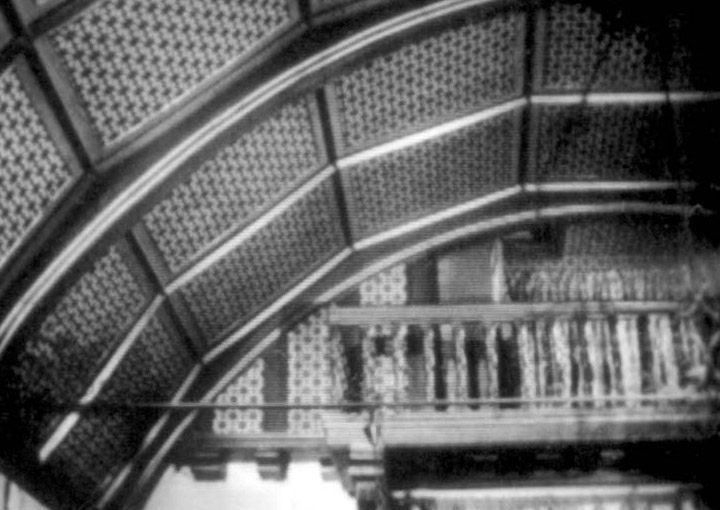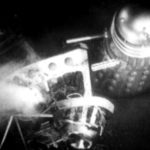Events from Apr 67 to Jun 67

A Final End for the Daleks … and Shawcraft
Whilst recording the previous Dalek serial at the start of November 1966, Terry Nation made another move to extricate his Dalek creations from the show that had spawned them. The pilot for his spin-off series was called The Destroyers and centered around the Space Security Service and the characters devised for The Daleks Master Plan.
The BBC wasn’t interested in producing this new series, so Nation approached broadcasters in America. The BBC’s response was to terminate the Daleks’ involvement with Doctor Who, and thus a story was devised to conclude the Doctor’s battle with the Daleks for good, and end the show’s fourth year.

New Companion Victoria at Grim’s Dyke Mansion
David Whitaker was given the task of writing an epic, sprawling season-finale. During January 1967 he redrafted the story-line which would carry the Doctor and Jamie to three time periods and two planets, taking the story of the Daleks full circle, back to their home world of Skaro where they would meet their demise.
It wasn’t just the Daleks leaving Doctor Who, but Ben and Polly were being written out too. By the beginning of March, the character of Samantha Briggs from The Faceless Ones had been chosen to replace them. When Pauline Collins declined the offer, the character of Victoria from the new Dalek script was upgraded to companion status, and on 11th April the role was awarded to Denise Buckley. But within 48 hours, plans changed again and the part had been re-cast with Deborah Watling.
Meanwhile, more significant production issues were coming to a head which would directly affect the future of the Dalek props forever. During mid-March 1967, a month before Evil of the Daleks was due to go into production, the creators and caretakers of the Dalek props, Shawcraft Models, were finding themselves increasingly out of favour with the Doctor Who production office.
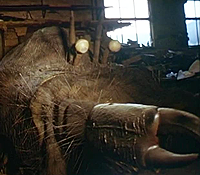
The Ungainly Macra at Shawcraft Workshops
Several of the props that had been so proudly on display at their Uxbridge workshops in the Follow That Dalek footage a month previously, were now at the centre of a bitter dispute. Firstly, the giant crab monsters known as Macra were received very badly in studio, and deemed almost unusable. Then, during the second week of April, the variable-geometry aircraft model and the accompanying satellite created for The Faceless Ones were struck by technical problems and breakages, resulting in lost studio time. The 11th April required a remount for model work on The Faceless Ones, and the resulting bad feeling meant that Shawcraft’s services were not going to be called upon again. All future work on the Dalek props would be carried out internally by the BBC, but the last throw of the dice came with Evil of the Daleks.
One final change worthy of note is that Roy Skelton was drafted in to accompany Peter Hawkins in providing the Dalek voices for this story, after Skelton had demonstrated his vocal skills earlier in the season providing the Cybermen’s voices in The Tenth Planet.
The Last Shawcraft Army
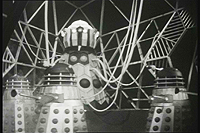
Four props at Ealing
For the Daleks’ swan song, all the available TV props were assessed at the beginning of April 1967 – only four months after their last television outing. The props that had featured in Power of the Daleks were brought from storage, and the prop kept at the workshops of Shawcraft models was reunited with the others.
This meant a pool of five existing props was available, consisting of: the two surviving first-generation props, Dalek One and Dalek Two, plus the two props built for The Dalek Invasion of Earth, Dalek Five and Dalek Six (with their tops now permanently swapped onto the wrong skirts), plus the movie-style prop built for The Chase, Dalek Seven, which had made its full debut in Power of the Daleks. To this collection, a bizarre new prop was added…
The Narrow Dalek – Prop Eight
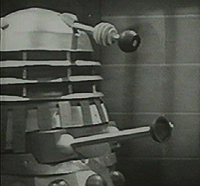
The New Dalek has five short slats
In addition to the batch of five previously-used Shawcraft props, a new creation was unveiled for Evil of the Daleks. A Dalek the like of which has never been seen before or since.
The new prop was generally built using the techniques employed by Shawcraft, but there were a host of differences. The fibreglass was applied very thinly, leading to a virtually transparent skirt through which the operators inside could see daylight.
The most notable difference was that instead of two columns of hemispheres at the rear, Dalek Eight only has a single column. The panel is accordingly much narrower, and as a consequence the rear corner panels are much steeper. The result is that the entire skirt is dramatically narrower.
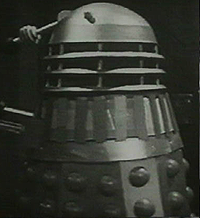
The New Dalek had one column of rear hemispheres
To fit the skirt, a slimmer set of shoulders had been constructed which meant the sides of the entire prop were altogether more parallel. The material used for the shoulder mesh of these thin shoulders was virtually opaque, having a plastic reflectivity to it. The longer slats were fitted in a haphazard manner and overhung the lower collar at the rear.
The misalignment of the hemispheres on the skirt panels retained all the customary quirks of the movie-style skirts, however the entire geometry of the skirt was changed to accommodate the smaller back panel. The neck and head display the characteristics of all props made after February 1965, as per the movie props and Curse of the Daleks props.
Other differences also suggested that the prop was not destined to be used as a ‘normal’ Dalek. Its gun and arm were fitted into static pivots that were made from spare hemispheres painted silver. The appendages themselves were also simplified. The gun was a made with a solid shaft and the arm only had a single stage.
Dalek Eight would ultimately become known as the “Wilkie Dalek” after Bernard Wilkie, the visual effects man at the BBC who took up the reigns on Doctor Who after Shawcraft’s involvement ended.
On Location and the Finale Battle at Ealing
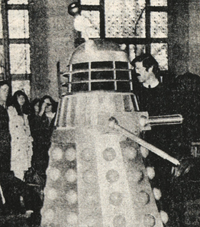
On Location at Grim’s Dyke Mansion House
Production started with location material at Grim’s Dyke Mansion House on 20th April 1967. This was used as Maxtible’s mansion and numerous scenes were recorded featuring not just rooms, but corridors, stairs and landing of the old house. Two props were taken on location for this work – the mixed-up Dalek Five-6 and the complete Dalek Seven.
The location schedule for 24th April 1967 indicates that, not only the “2 mobile Daleks” were required, but also “1 mini Dalek”. This would be Dalek Eight.
Scenes filmed on that day included Jamie and Kemel in the ‘Minstrel Gallery’ – a large room with an indoor balcony set high up at one end. The script for the scene set on the balcony makes reference to the “mini Dalek” and the fact that a Dalek enters the balcony area through a door to confront Jamie and Kemel.
The stairway and two passageways to the balcony (one either side) were very narrow and not wide enough for a standard Dalek to fit through. Dalek Eight was made specifically to be able to enter the balcony area in order for these scenes to be completed1.
Also taken was the detailed FX destroyed shoulder section that had been used in the final shots of Power of the Daleks. It was utilised for the aftermath of the Dalek being pulled through the gallery bannister by Jamie and Kemel. It lay alongside a newly created FX skirt section.
Filming continued until the 25th. The following day, filming switched to Ealing Studios for another two days. As had happened with the final battle scene in The Chase and episode six of Power of the Daleks, the climax of Evil of the Daleks was to be shot on film rather than video to assist with the editing of the complex sequences featured in episode seven.
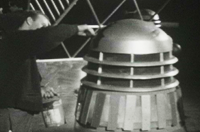
A dome painted black during filming
Following the location shoot at Grim’s Dyke, the various prop components had gone back into the pool of casings, but when they re-emerged for the additional work at Ealing, a great deal of mixing had taken place. The four props assembled for the filming of episode seven were as follows (Top half stated first, skirt given a numeral): Dalek Two-1, Dalek Seven-2, Dalek Six-5, Dalek Five-6. This meant that where Dalek Seven had previously been complete, it was now used with the skirt of Dalek Two, whilst the top of Dalek Two was paired with the skirt of Dalek One. Strangely however the top half of Dalek One remained unused. This meant that including the new thin Dalek, a total of five-and-a-half props as they were swapped around through the story.
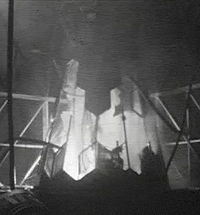
Destruction of the First Emperor Prop
In these scenes a civil war erupts between the original Daleks and a new breed created by the Doctor which contained a “human factor”. The Dalek props were initially shot in their all-grey livery, and then a hasty paint job was done to create three Throne Room Daleks which accompanied a gigantic Dalek Emperor Dalek.
The domes of Dalek Two-1, Dalek Seven-2, Dalek Five-6 were painted black to become this new rank. Such was the rush in which the production was made, scenes were shot in which the paint was clearly still wet. Only Dalek Six-5 remains unpainted.
At the end of the battle, Dalek Two-1 is left as a dead prop facing the wall with its head missing, and a Dalek mutant was created to writhe and bubble at the neck of the prop. The top half of this prop still has its extruded gun seen in Power of the Daleks. This filming sequence featured the destruction of the new Emperor prop, with its panels blown and melted away, and the structure collapsing.
After these devastating scenes, the props were cleaned up and refurbished as necessary for their return to studio the following week.
Into Studio
Video recording began at Lime Grove on 13th May and required only one prop for the climax of the first episode where it appeared in the secret room of the antique shop. For this scene, Dalek Five-6 was used – the prop that had been left out of Power of the Daleks and kept at Shawcraft. Due to being excluded from the refurbishments of the previous year, it remained the only prop with an original tapered eye-stalk and old-style eye-ball. The damaged mesh behind the gunbox seen in the Follow that Dalek footage remained unrepaired.
An additional two days’ filming were mounted at Ealing on May 16th and 17th to shoot more footage on film.
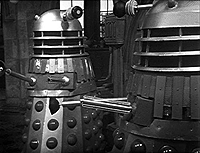
An empty casing on the right saved money on hiring an operator
The following Saturday, episode two was recorded on 20th May. This saw the first confirmed use of the narrow Dalek Eight prop, which acts as prison guard to Victoria. At the end of the episode a further two props were employed, however in a shrewd financial move no additional operator was contracted, leaving just Robert Jewell to operate Dalek Six-5, whilst Dalek Five-6 stayed static on the right of picture. The former still displayed its distinctive armbox patch on the top half, and recent triple-bolt addition on the skirt.
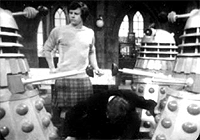
Alpha, Beta and Omega
27th May saw the recording of episode three for which less studio work was needed as a lot of action had been captured on location. Dalek operators were still using sparingly, allowing for frugality in contracting the required number for any scene. Episode four was recorded on 3rd June and only used two operators whilst episode five was recorded using three operators on 10th June.
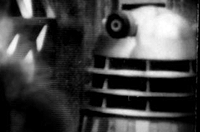
A pupil appears on the eye of Dalek Five-6
Episode six was the first occasion on which four Daleks were needed for one scene, and Robert Jewell, Gerald Taylor, John Scott Martin and Murphy Grumbar were all employed. This episode included a scene in which the thin Dalek Eight masqueraded as an ally of the Doctor, only to be dispatched over the edge of a cliff.
One new addition for this story also came in episode six – the appearance of a black “pupil” within the white of the eye. The telesnaps and studio photos reveal that Dalek Six-5 and Dalek Five-6 both had their eyes adjusted2.
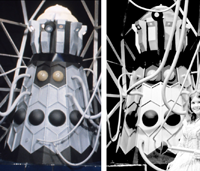
First Emperor (left) at Ealing for Filming Second Emperor (right) at Lime Grove
This episode culminated in the reveal of the Emperor Dalek and although the walls of the set had been salvaged from the film shoot at Ealing, the gigantic cone-shaped leader himself had to be rebuilt. The second Emperor was superficially identical, but with broader front panels, which made the gaps between the edges of its hemispheres and the fret-work seem larger. The pipes on the Ealing Emperor had been symmetrically arranged whereas in the video studio they crossed over more. The lights around the perimeter of the head were also different. For this momentous encounter the script suggested that this Emperor and the Doctor know each other as old enemies, although they have never met.
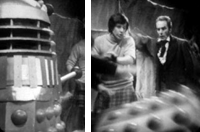
The thin Dalek (later known as the Wilkie) is pushed over a cliff
Via the studio work on 24th June and the pre-recorded battle filmed at Ealing, episode seven used a total of five props and also five operators, with Ken Tyllsen being the addition. Four normal Daleks plus the thin Dalek Eight were used, with the Dalek One-7 being left out of recording, being the original top, plus the movie-style skirt.
The Evil of the Daleks saw the Doctor conclude that the Daleks had met their final end and many years would pass before the decision to remove the Daleks from Doctor Who was reversed. In the meantime, their adventures would continue off-screen…
Next Page: Five Years In The Cold
-
With thanks to Simon Guerrier for the information on the layout of the balcony.
-
With limited source material its hard to be sure exactly how many of the Dalek props had the pupil addition in the episodes themselves. However, photos taken in the months after recording (such as the Blue Peter ‘Design-a-Monster’ promotional images) show that Dalek Seven-2 and Dalek Two-1 also have pupils.
